Limestones in the Roman Architecture of Oderzo and Concordia Sagittaria (Italy): Petrography and Provenance
Abstract
1. Introduction
1.1. Oderzo in the Roman Age
1.2. Concordia Sagittaria in the Roman Age
2. Materials and Methods: Sampling and Analytical Equipment
3. Results—Petrofacies
4. Discussion
4.1. Quarry Basins and Transport Routes
4.2. The Use of Limestones in the Main Roman Cities of Eastern Veneto
5. Conclusions
Author Contributions
Funding
Data Availability Statement
Conflicts of Interest
References
- Previato, C. Aquileia, Materiali, Forme e Sistemi Costruttivi dall’età Repubblicana alla Tarda età Imperiale; Padova University Press: Padova, Italy, 2015. [Google Scholar]
- Secco, M.; Dilaria, S.; Addis, A.; Bonetto, J.; Artioli, G.; Salvadori, M. Evolution of the Vitruvian Recipes over 500 Years of Floor Making Techniques: The Case Studies of Domus delle Bestie Ferite and Domus di Tito Macro (Aquileia, Italy). Archaeometry 2018, 60, 185–206. [Google Scholar] [CrossRef]
- Dilaria, S.; Sbrolli, C.; Stella Mosimann, F.; Favero, A.; Secco, M.; Santello, L.; Salvadori, M. Production Technique and Multi-Analytical characterization of a Paint-Plastered ceiling from the Late Antique Villa of Negrar (Verona, Italy). Archaeol. Anthropol. Sci. 2024, 16, 74. [Google Scholar] [CrossRef]
- Dilaria, S.; Secco, M.; Rubinich, M.; Bonetto, J.; Miriello, D.; Barca, D.; Artioli, G. High-performing mortar-based Materials from Late Imperial Baths of Aquileia. An outstanding example of Roman building tradition in Northern Italy. Geoarchaeology 2022, 37, 637–657. [Google Scholar] [CrossRef]
- Dilaria, S.; Secco, M.; Ghiotto, A.R.; Furlan, G.; Giovanardi, T.; Zorzi, F.; Bonetto, J. Early Exploitation of Neapolitan Pozzolan (Pulvis puteolana) in the Roman Theatre of Aquileia, Northern Italy. Sci. Rep. 2023, 13, 4110. [Google Scholar] [CrossRef]
- Dilaria, S.; Ricci, G.; Secco, M.; Beltrame, C.; Costa, E.; Giovanardi, T.; Bonetto, J.; Artioli, G. Vitruvian binders in Venice: First evidence of phlegraean Pozzolans in an underwater Roman construction in the Venice Lagoon. PLoS ONE 2024, 19, e0313917. [Google Scholar] [CrossRef]
- Dilaria, S. Archaeometry of ancient mortar-based materials in Roman Regio X and neighboring territories: A first review. Minerals 2025, 15, 746. [Google Scholar] [CrossRef]
- Dilaria, S. Archeologia e Archeometria delle Miscele Leganti di Aquileia Romana e Tardo Antica (II Sec. a.C.—VI Sec. d.C.); Quasar: Rome, Italy, 2024. [Google Scholar]
- Girotto, C.; Dilaria, S.; Previato, C.; Bonetto, J.; Mazzoli, C. The use of stone resources in the Roman architecture of Oderzo (Treviso, Italy). Heritage 2025, 8, 44. [Google Scholar] [CrossRef]
- Navarro, R.; Martínez-Martínez, J.; Fernández Suárez, J.; Álvarez-Areces, E.; Manuel Baltuille, M. Comparative Analysis of the Current Uneven Situation of Historical Quarries Associated with the UNESCO World Heritage Sites in Spain. Resour. Policy 2022, 75, 102471. [Google Scholar] [CrossRef]
- Brilli, M.; Giustini, F.; Conte, A.M.; Lapuente Mercadal, P.; Quarta, G.; Royo Plumed, H.; Scardozzi, G.; Belardi, G. Petrography, geochemistry, and cathodoluminescence of ancient white marble from quarries in the Southern Phrygia and Northern Caria Regions of Turkey: Considerations on provenance discrimination. J. Archaeol. Sci. Rep. 2015, 4, 124–142. [Google Scholar] [CrossRef]
- Bednarik, M.; Moshammer, B.; Heinrich, M.; Holzer, R.; Laho, M.; Rabeder, J.; Uhlir, C.; Unterwurzacher, M. Engineering geological properties of Leitha Limestone from historical quarries in Burgenland and Styria, Austria. Eng. Geol. 2014, 176, 66–78. [Google Scholar] [CrossRef]
- Ruta Serafini, A.; Balista, C. Oderzo: Verso la Formazione della Città. In Protostoria e Storia del ‘Venetorum Angulus’: Atti del XX Convegno di Studi Etruschi ed Italici, Portogruaro, Quarto d’Altino, Este, Adria (16–19 Ottobre 1996); Istituti Editoriali e Poligrafici Internazionli: Pisa, Italy, 1999; pp. 73–90. [Google Scholar]
- Tirelli, M. Oderzo. In Il Veneto nell’età Romana: Note di Urbanistica e di Archeologia del Territorio; Cavalieri Manasse, G., Ed.; Banca Popolare di Verona: Verona, Italy, 1987; Volume 2, pp. 358–390. [Google Scholar]
- Busana, M.S. Oderzo, Forma Urbis, Saggio di Topografia Antica; L’Erma di Bretschneider: Rome, Italy, 1995. [Google Scholar]
- Tirelli, M.; Sandrini, G.M. Oderzo. Saggio di scavo nei quartieri nord-occidentali. Quad. Archeol. Veneto 1989, 6, 134–148. [Google Scholar]
- Ruta Serafini, A.; Tirelli, M. Dalle origini all’alto medioevo: Uno spaccato urbano di Oderzo dallo scavo dell’ex Stadio. Quad. Archeol. Veneto 2004, 20, 135–152. [Google Scholar]
- Tirelli, M. l'Area del Foro di Oderzo (Treviso). In La Città Nella Città, Sistemazione di Resti Archeologici in Area Urbana: L'Italia del Nord; Croce Da Villa, P., Dal Pos, M., Penzo, M., Eds.; Tipografia Sagittaria: Concordia Sagittaria, Italy, 1989; pp. 39–47. [Google Scholar]
- Tirelli, M. Oderzo. Zona monumentale e quartieri di abitazioni di epoca romana tra via Roma e via Mazzini. Quad. Archeol. Veneto 1985, 1, 31–34. [Google Scholar]
- Tirelli, M. Oderzo: Resti di basolato stradale tra Piazza Vittorio Emanuele e Piazza Castello. Quad. Archeol. Veneto 1989, 5, 75–76. [Google Scholar]
- Cipriano, S.; Sandrini, G.M. La Banchina Fluviale di Opitergium. In Antichità Altoadriatiche; Centro di Antichità Altoadriatiche: Trieste, Italy, 2001; Volume 46, pp. 289–294. [Google Scholar]
- Bonetto, J. Mura e Città nella Transpadana Romana, l’Album; Fondazione Antonio Colluto: Portogruaro, Italy, 1998; Volume 5. [Google Scholar]
- Bonetto, J. Veneto; Istituto Poligrafico e Zecca Dello Stato: Rome, Italy, 2009. [Google Scholar]
- Tirelli, M. Opitergium, Municipio Romano. In l’Anima delle Cose, Riti e Corredi dalla Necropoli Romana di Opitergium, Catalogo della Mostra, 24 Novembre 2019–31 Maggio 2020; Mascardi, M., Tirelli, M., Eds.; Digital Publishing: Venezia, Italy, 2019; pp. 27–36. [Google Scholar]
- Braconi, M. Il Banchetto e la Caccia su due Mosaici Pavimentali di Oderzo fra Tradizione Iconografica e Autorappresentazione. In Antichità Altoadriatiche; EUT Edizioni Università di Trieste: Trieste, Italy, 2016; Volume 86, pp. 281–300. [Google Scholar]
- Castagna, D.; Tirelli, M. Evidenze Archeologiche di Oderzo Tardo-Antica ed Altomedievale: I Risultati Preliminari di Indagini Recenti. In Città, Castelli, Campagne nei Territori di Frontiera (Secoli VI–VII), Documenti di Archeologia; Brogiolo, G.P., Ed.; SAP Società Archeologica: San Lorenzo, Italy, 1995; Volume 6, pp. 121–134. [Google Scholar]
- Tirelli, M. Spolia dalla Necropoli Opitergina: Monumenta. In La Necropoli di Opitergium, Atti Della Giornata di Studi Intorno alla Mostra l’Anima Delle Cose, Antichistica Archeologia; Mascardi, M., Tirelli, M., Vallicelli, M.C., Eds.; Edizioni Ca’ Foscari: Venice, Italy, 2023; Volume 35, pp. 11–30. [Google Scholar]
- Fontana, A. Evoluzione Geomorfologica Della Bassa Pianura Friulana; Forum Editrice Universitaria Udinese: Udine, Italy, 2006. [Google Scholar]
- Bosio, L. Le Strade Romane della Venetia e dell’Histria; Il Poligrafo: Padova, Italy, 1997. [Google Scholar]
- Uggeri, G. La nuova Via Annia da Roma ad Aquileia (153 a.C.). J. Anc. Topogr. 2012, 22, 157–158. [Google Scholar]
- Croce Da Villa, P. Le Mura di Cinta. In Concordia Sagittaria, Tremila Anni di Storia; Croce Da Villa, P., Di Filippo Balestrazzi, E., Eds.; Il Poligrafo: Padova, Italy, 2001; pp. 146–158. [Google Scholar]
- Da Villa, C.P. Il Foro di Concordia: Scavi Recenti. In Antichità Altoadriatiche; Arti Grafiche Friulane: Udine, Italy, 1995; pp. 205–216. [Google Scholar]
- Da Villa, C.P. Proposte interpretative sulle terme di Iulia Concordia. Quad. Archeol. Veneto 2008, 24, 165–174. [Google Scholar]
- Di Filippo Balestrazzi, E. Il Teatro Romano di Concordia. In Antichità Altoadriatiche; Centro di Antichità Altoadriatiche: Udine, Italy, 1994; Volume 41, pp. 183–206. [Google Scholar]
- Ghedini, F.; Annibaletto, M. Atria Longa Patescunt: Le Forme dell’Abitare Nella Cisalpina Romana; Quasar: Rome, Italy, 2012; Volume 2. [Google Scholar]
- Croce Da Villa, P. Le Case. In Concordia Sagittaria, Tremila Anni di Storia; Croce Da Villa, P., Di Filippo Balestrazzi, E., Eds.; Il Poligrafo: Padova, Italy, 2001; pp. 174–192. [Google Scholar]
- Trevisanato, A. Cinta Muraria e Porte Urbiche di Iulia Concordia: Analisi Strutturale ed Ipotesi di Ricostruzione Architettonica; L’Album: Portogruaro, Italy, 1999; Volume 6. [Google Scholar]
- Croce Da Villa, P. Concordia Sagittaria. Tremila Anni di Storia; Il Poligrafo: Padova, Italy, 2001. [Google Scholar]
- Da Villa, C.P. Concordia Sagittaria (Venezia). Piazza della Cattedrale. In La Città Nella Città, Sistemazione di Resti Archeologici in Area Urbana: L’Italia del Nord; Croce Da Villa, P., Dal Pos, M., Penzo, A., Eds.; Comune di Concordia Sagittaria: Concordia Sagittaria, Italy, 1989; pp. 17–25. [Google Scholar]
- Previato, C. Aurisina Limestone in the Roman Age: From Karst Quarries to the Cities of the Adriatic Basic. In ASMOSIA XI: Interdisciplinary Studies of Ancient Stone: Proceedings of the Eleventh International Conference of ASMOSIA, Split, Croatia, 18–22 May 2015; Matetić Poljak, D., Marasović, K., Eds.; Arts Academy: Split, Croatia, 2018; pp. 933–939. [Google Scholar]
- Cucchi, F.; Biolchi, S.; Zini, L.; Jurkovšek, B.; Kolar-Jurkovsek, T. Geologia e geomorfologia del Carso Classico. In Le Acque del Carso Classico, Progetto Hydrokarst/Vodonosnik Klasičnega Krasa, Projekt Hydrokarst; EUT–Edizioni Università di Trieste: Trieste, Italy, 2015; pp. 23–52. [Google Scholar]
- Jurkovšek, B.; Biolchi, S.; Furlani, S.; Kolar-Jurkovšek, T.; Zini, L.; Jež, J.; Tunis, G.; Bavec, M.; Cucchi, F. Geology of the Classical Karst Region (SW Slovenia–NE Italy). J. Maps 2016, 12, 352–362. [Google Scholar] [CrossRef]
- Maritan, L.; Mazzoli, C.; Melis, E. A Multidisciplinary Approach to the Characterization of Roman Gravestones from Aquileia (Udine, Italy). Archaeometry 2003, 45, 363–374. [Google Scholar] [CrossRef]
- Astolfi, G.C.F. La Geologia dei Colli Euganei; Programma: Padova, Italy, 1990. [Google Scholar]
- Cornale, P.; Rosanò, P. Le Pietre Tenere del Vicentino, Uso e Restauro; La Grafica & Stampa Ed: Vicenza, Italy, 1994. [Google Scholar]
- Massari, F.M.F. Stratigrafia e paleogeografia del Campaniano e Maastrichtiano nelle Alpi Meridionali (con particolare riguardo agli Hard Grounds della Scaglia Rossa Veneta). Mem. Ist. Geol. Mineral. Univ. Padova 1963, 28, 1–64. [Google Scholar]
- Barbieri, G.; Dal Piaz, G.V.; Dal Pra, A.; De Zanche, V.; Grandesso, P.; Mietto, P.; Sedea, R.; Zanferrari, A. Carta Geologica del Veneto 1:250,000: Una Storia di Cinquecento Milioni di Anni; Regione del Veneto: Venice, Italy, 1990. [Google Scholar]
- Coletti, C.; Antonelli, F.; Germinario, L.; Maritan, L.; Piovesan, R.; Tesser, E.; Mazzoli, C. Investigating stone materials from some European cultural heritage sites for predicting future decay. Rend. Lincei. Sci. Fis. Nat. 2025, 36, 103–127. [Google Scholar] [CrossRef]
- Salvini, S.; Coletti, C.; Maritan, L.; Massironi, M.; Pieropan, A.; Spiess, R.; Mazzoli, C. Petrographic characterization and durability of carbonate stones used in UNESCO World Heritage Sites in Northeastern Italy. Environ. Earth Sci. 2023, 82, 49. [Google Scholar] [CrossRef]
- Salvini, S.; Coletti, C.; Maritan, L.; Massironi, M.; Balsamo, F.; Mazzoli, C. Exploring the pore system of carbonate rocks through a multi-analytical approach. Environ. Earth Sci. 2023, 82, 564. [Google Scholar] [CrossRef]
- Lazzarini, L. Pietra d’Istria: Genesi, proprietà e cavatura della pietra di Venezia. In La Pietra d’Istria e Venezia, Atti del Seminario di Studio; Fiorentin, N., Ed.; Cierre Edizioni: Verona, Italy, 2006; pp. 24–45. [Google Scholar]
- Rosada, G. La direttrice endolagunare e per acque interne nella decima regio maritima: Tra risorsa naturale e organizzazione antropica. In La Venetia Nell'Area Padano-Danubiana: Le Vie di Comunicazione: Convegno Internazionale, Venice, Italy, 6–10 April 1988; CEDAM: Padova, Italy, 1990; pp. 153–182. [Google Scholar]
- Russell, B. The Economics of the Roman Stone Trade. In Oxford Studies on the Roman Economy; Oxford University Press: Oxford, UK, 2013. [Google Scholar]
- Rosada, G. I fiumi e i porti nella Venetia orientale: Osservazioni intorno a un famoso passo pliniano. Aquil. Nostra 1979, 50, 173–256. [Google Scholar]
- Previato, C.; Zara, A. Il trasporto della pietra di Vicenza in Età Romana. Il relitto del fiume Bacchiglione. Marmora 2014, 10, 59–78. [Google Scholar]
- Bortolin, R. I materiale del “Circolo Antiqui” e l’area del teatro di Iulia Concordia. In Dalla Catalogazione alla Promozione dei Beni Archeologici; Regione del Veneto: Venice, Italy, 2014; pp. 81–90. [Google Scholar]
- Carulli, G.B.; Onofri, R. I Marmi Del Carso; Del Bianco Editore: Udine, Italy, 1960. [Google Scholar]
- Bonetto, J.; Dilaria, S.; Girotto, C.; Previato, C.; Falezza, G.; Facchi, A. Tra le cave e il Delta Del Po: Vie di trasporto e dinamiche del commercio della pietra. Atlante Temat. Topogr. Antica 2025, 35, 329–358. [Google Scholar]
- Dilaria, S.; Bonetto, J.; Germinario, L.; Previato, C.; Girotto, C.; Mazzoli, C. The stone artifacts of the National Archaeological Museum of Adria (Rovigo, Italy): A noteworthy example of heterogeneity. Archaeol. Anthropol. Sci. 2024, 16, 14. [Google Scholar] [CrossRef]
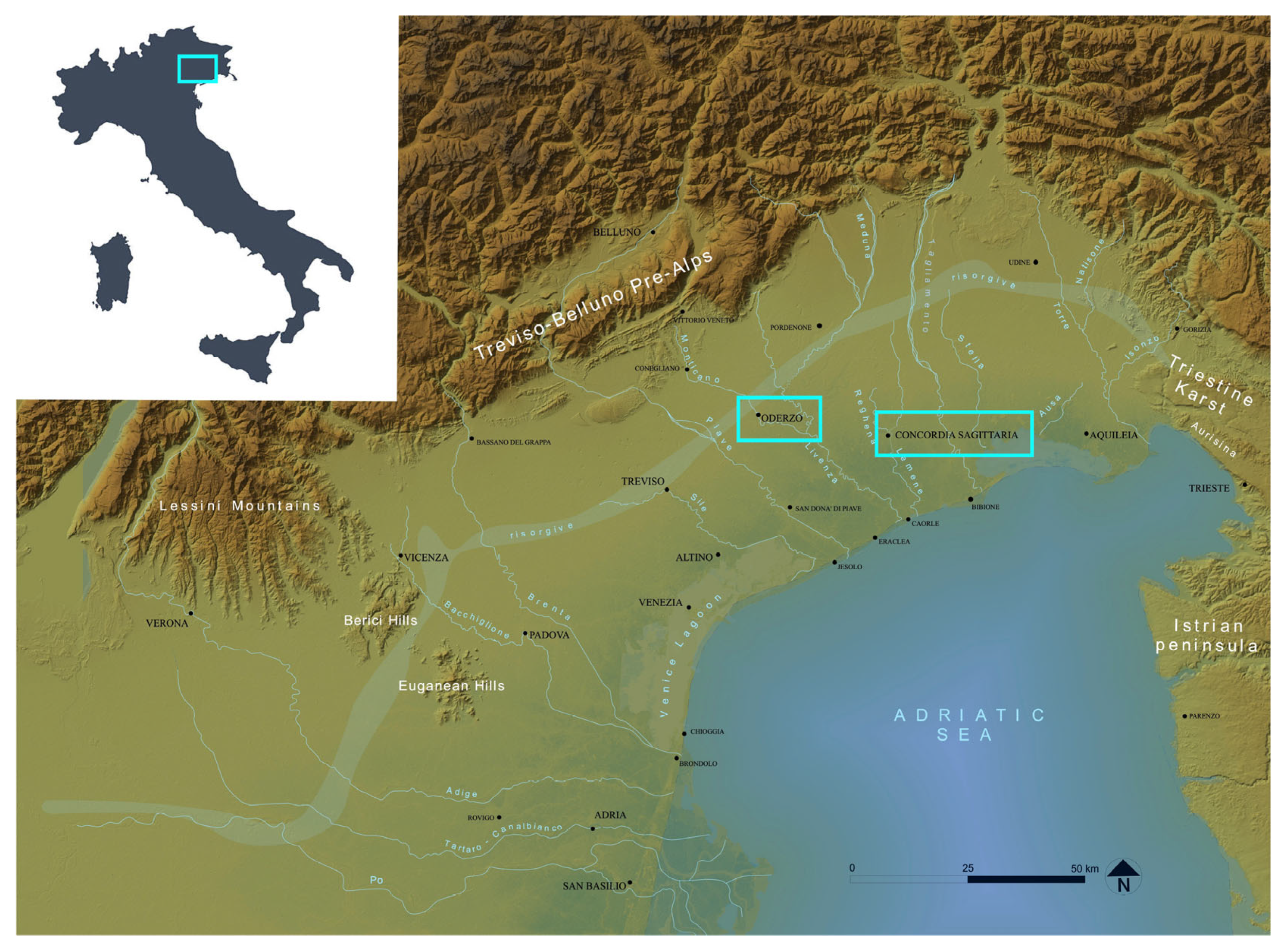
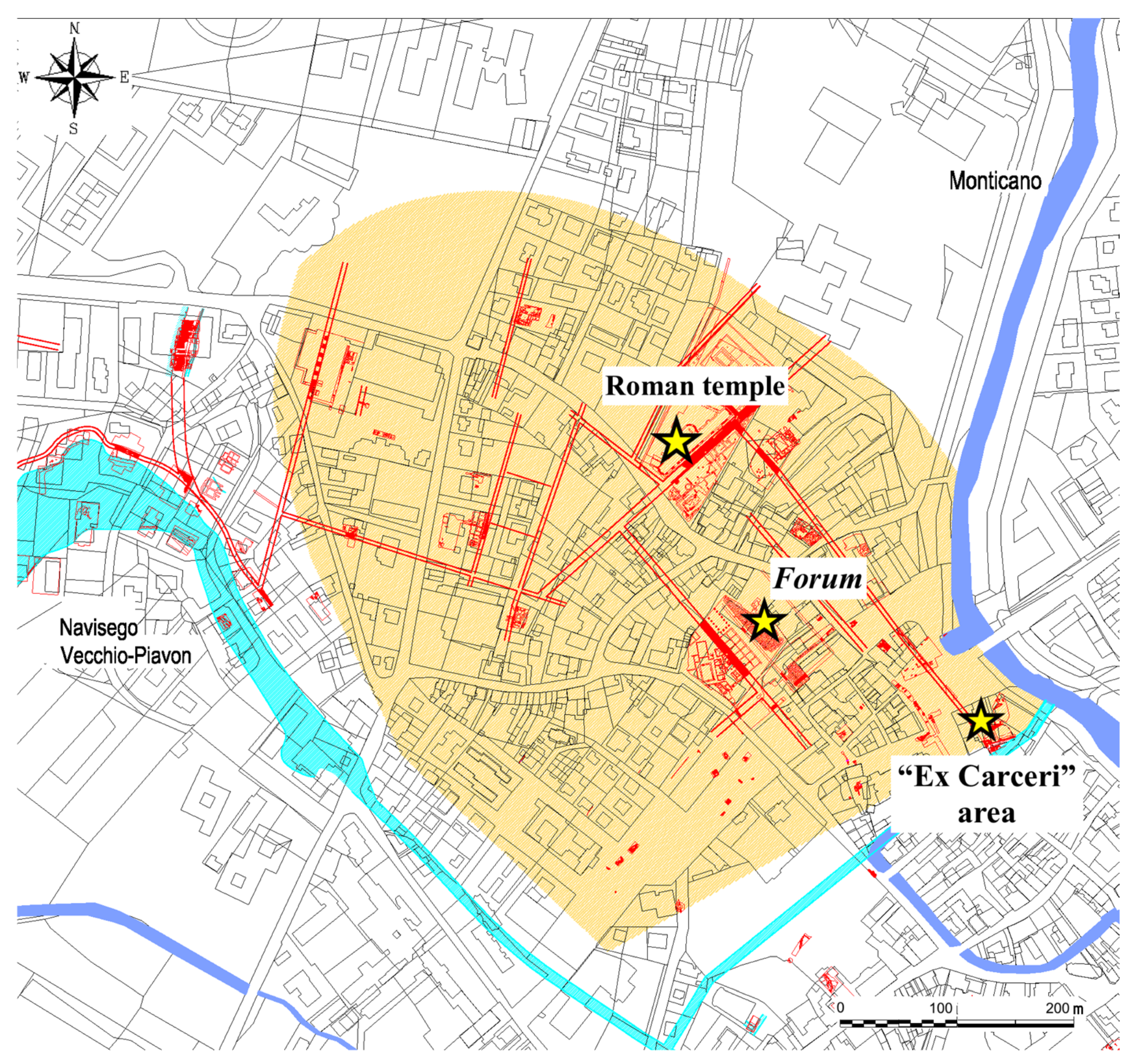
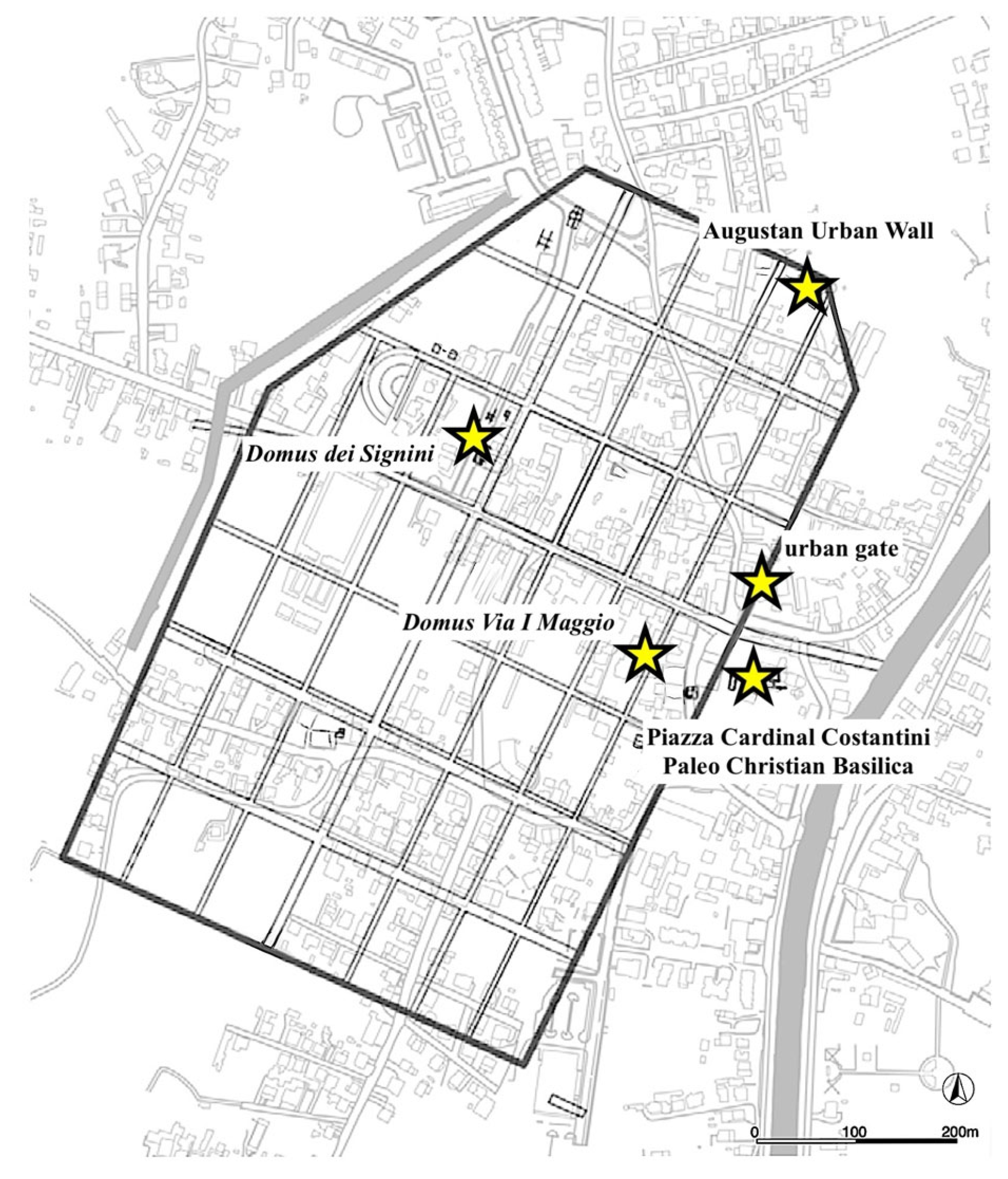

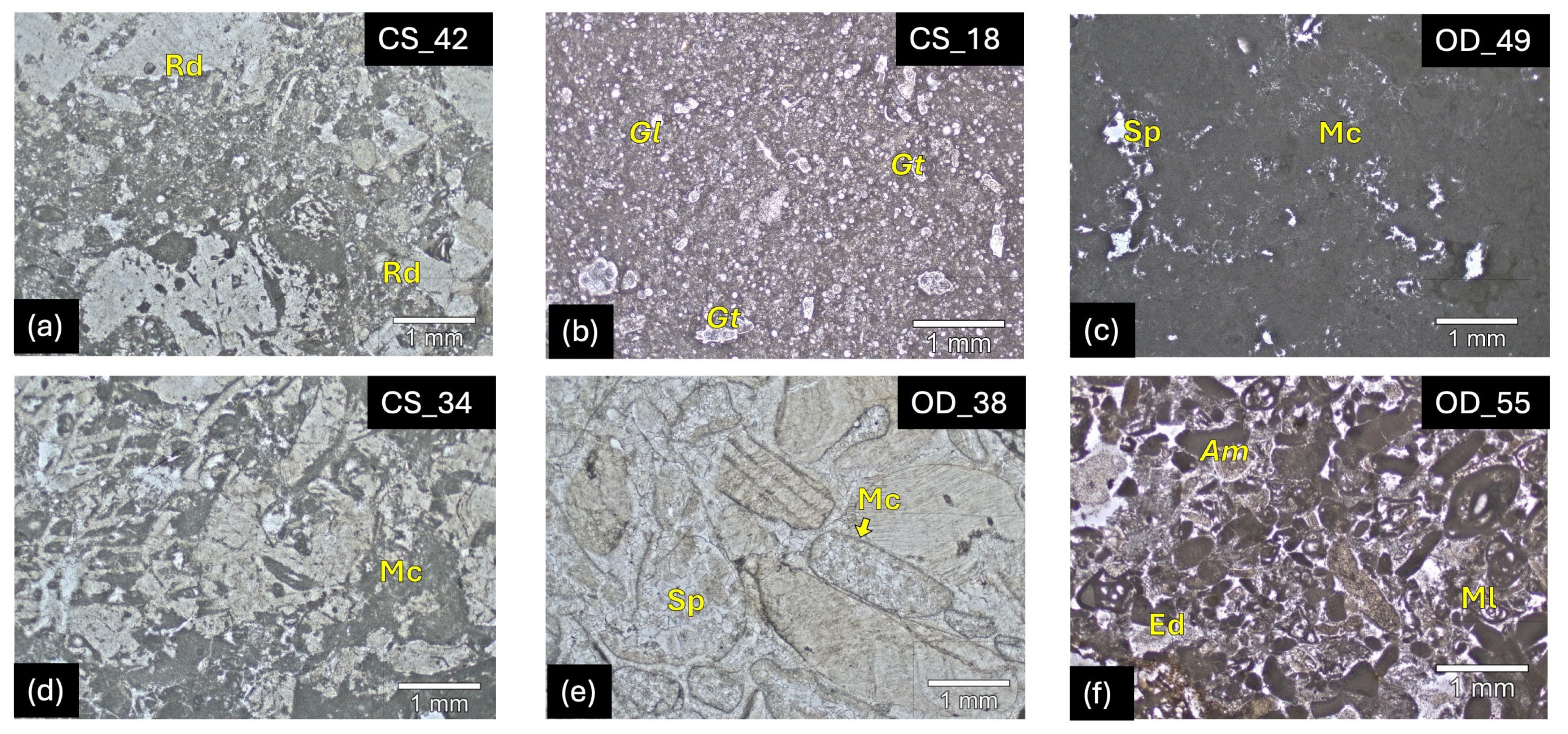
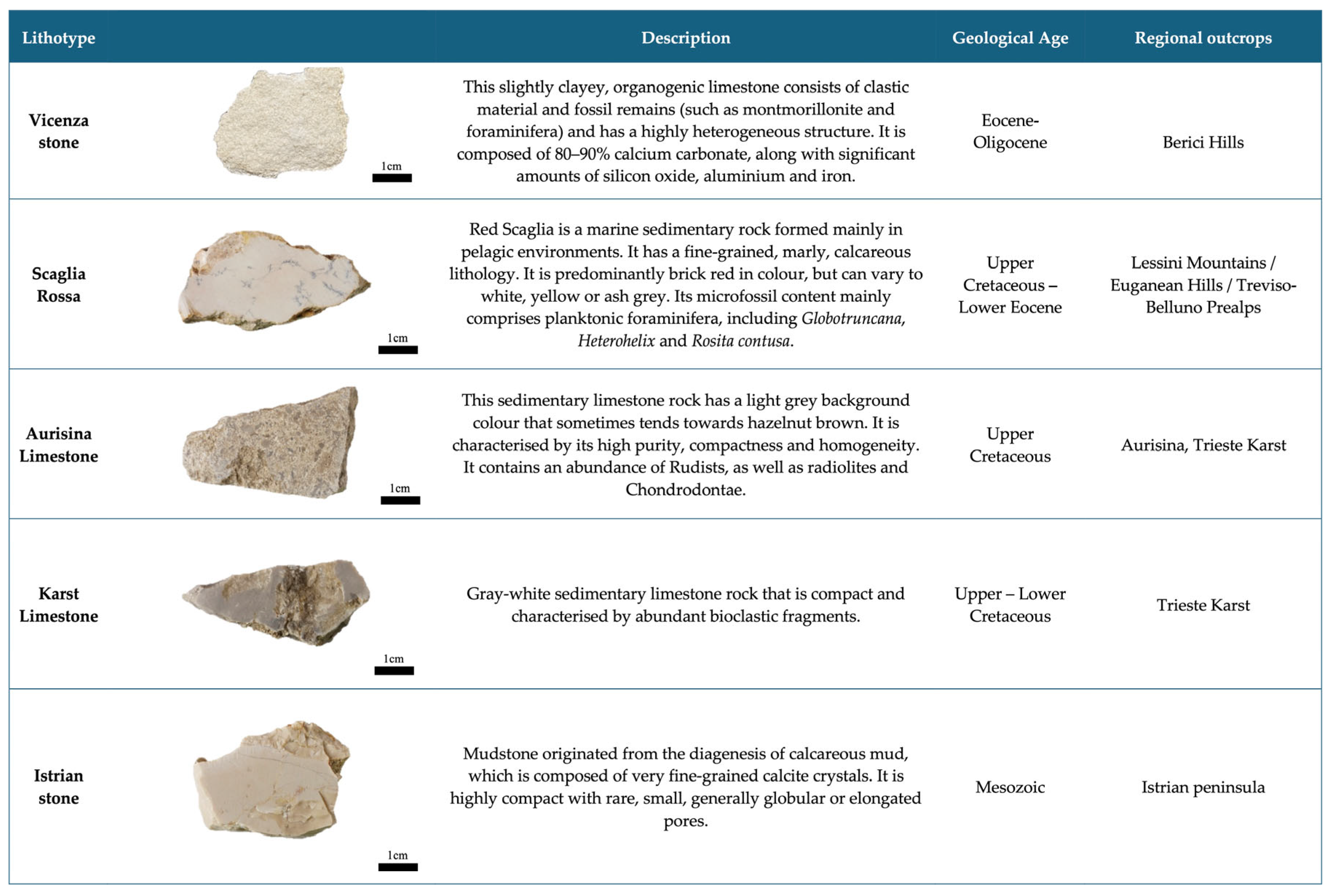
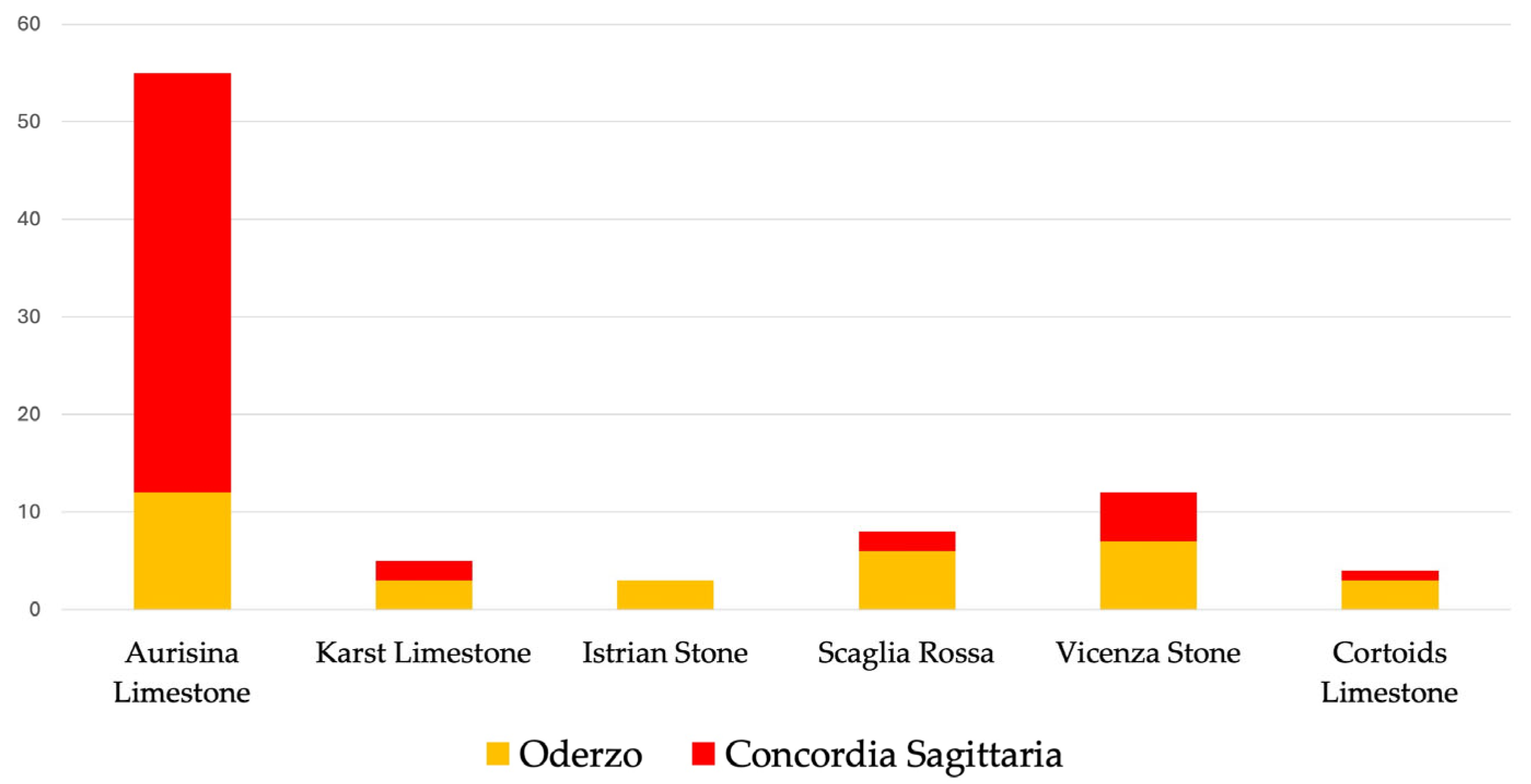
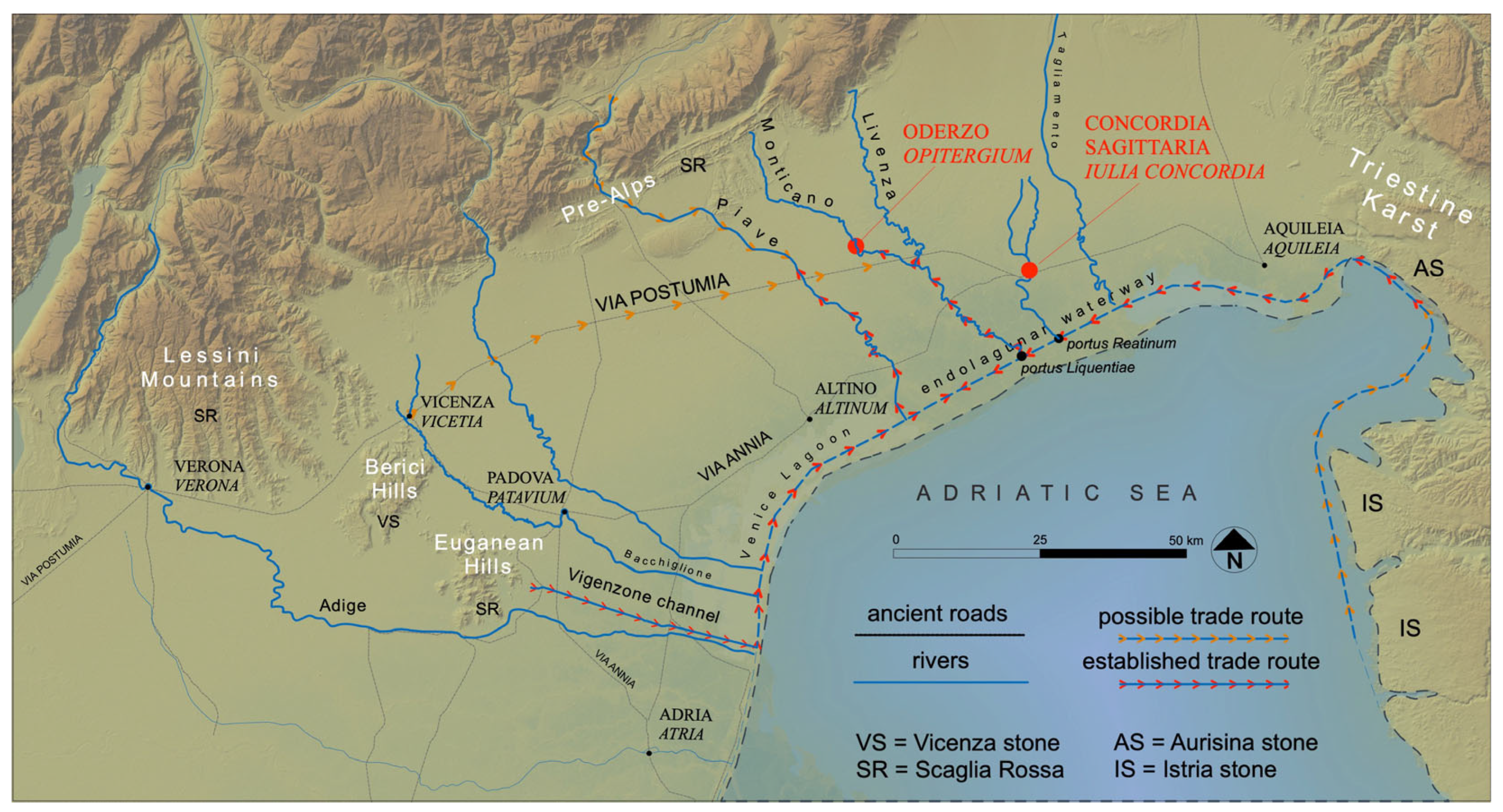
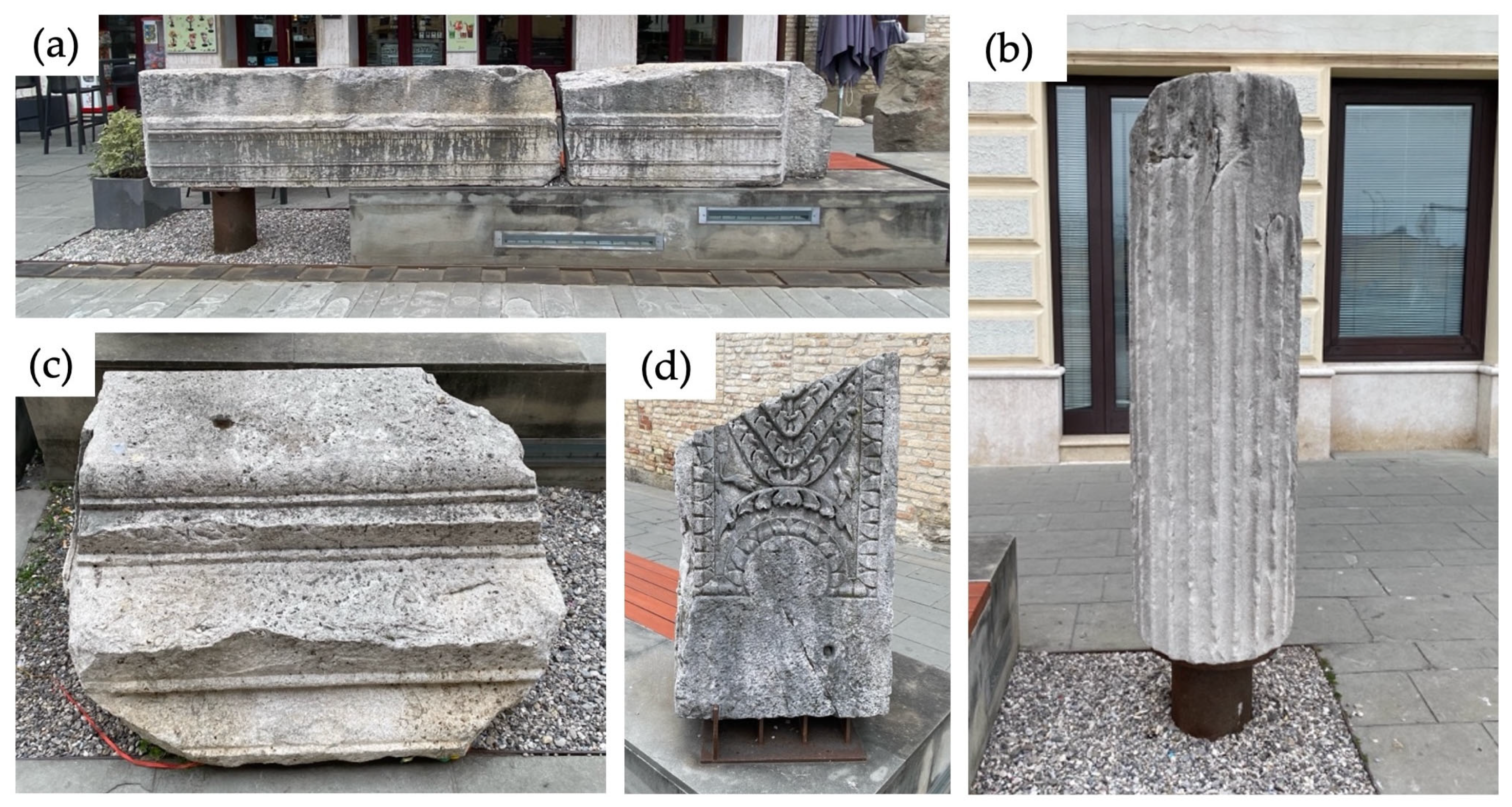
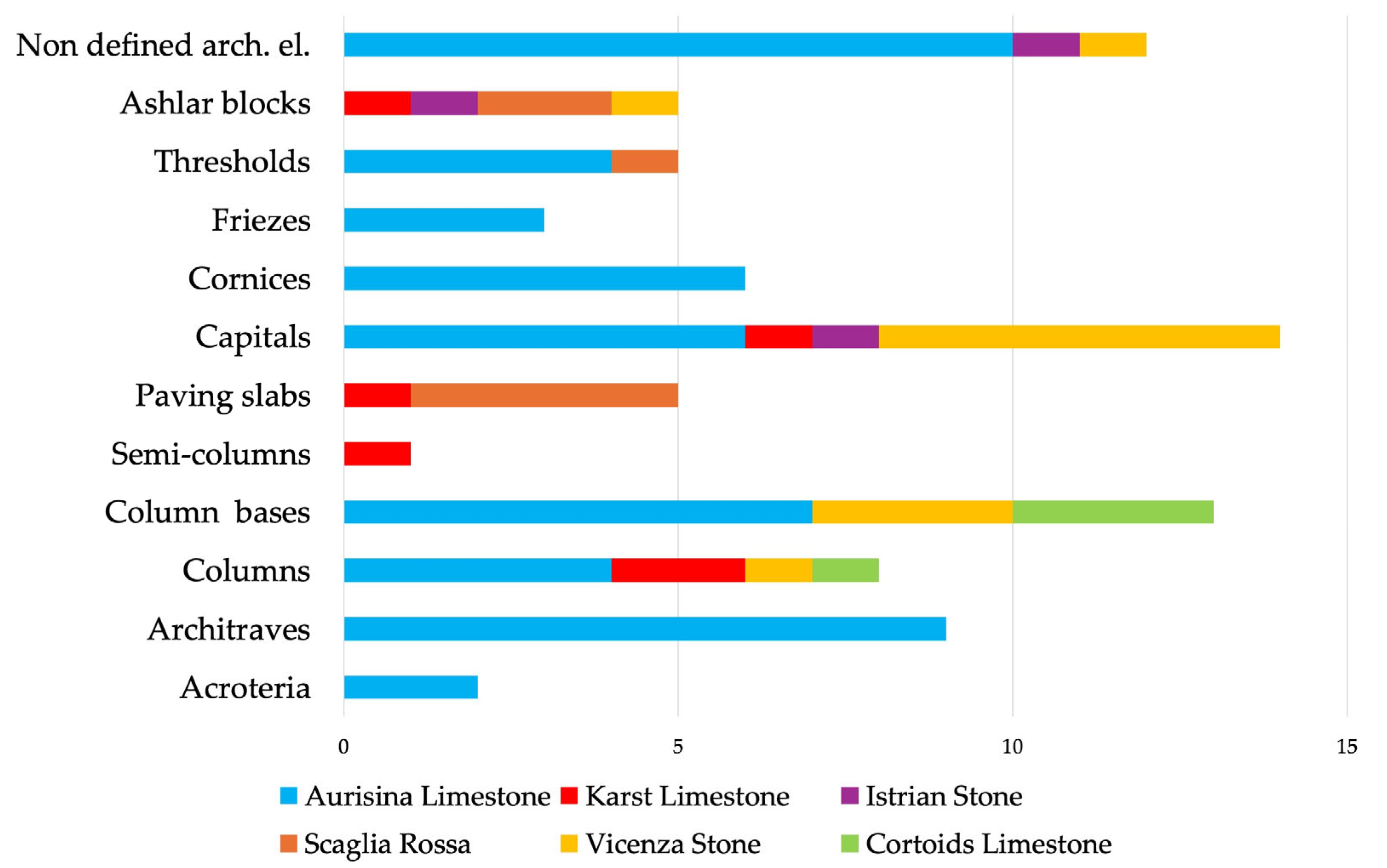
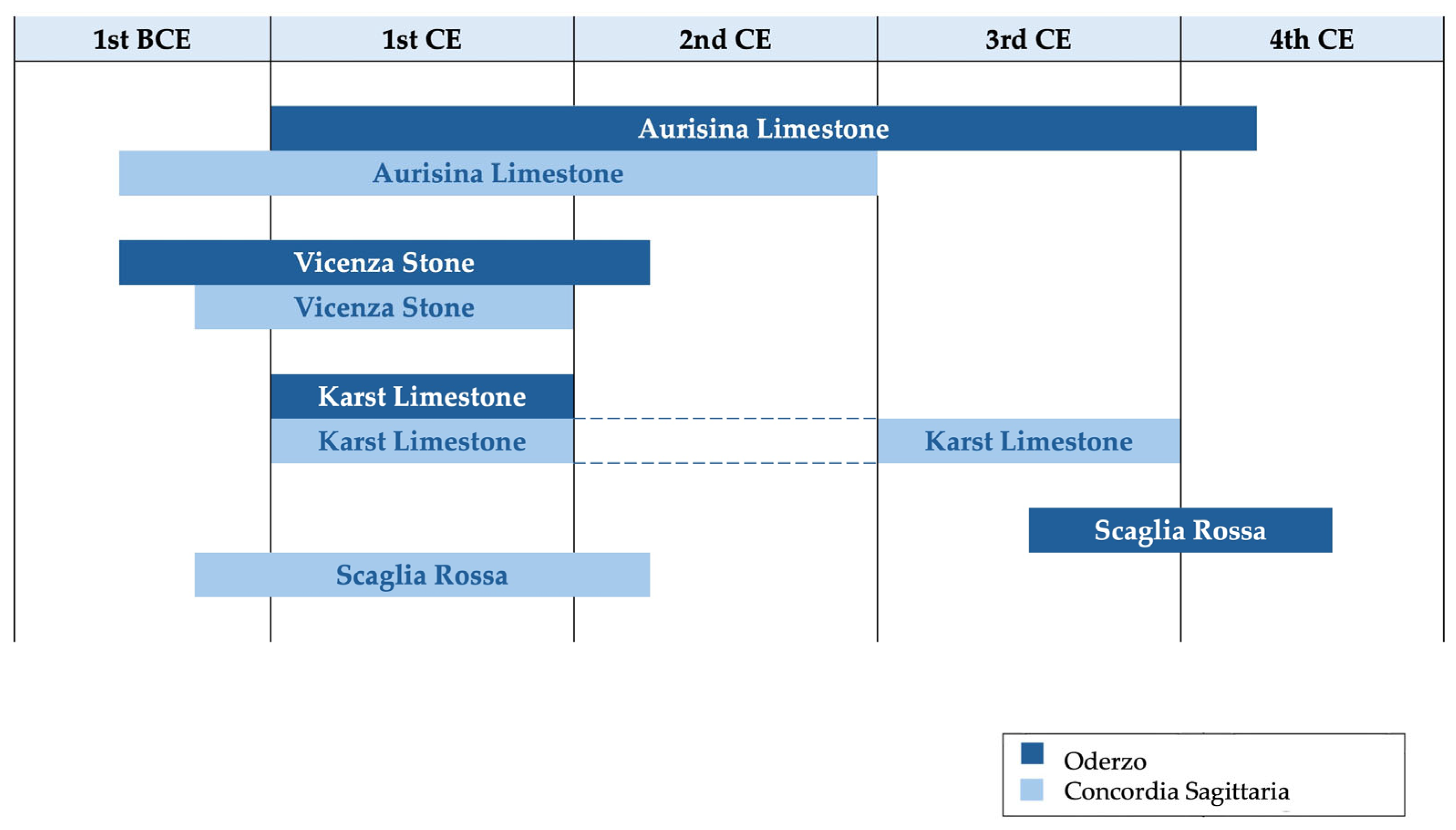
| Sample | Artefact/Structure | Context | Chronology | Lithotype | Provenance |
|---|---|---|---|---|---|
| OD_06 | paving stone | Oderzo, urban gate (“Ex Carceri” Area) | 3rd-4th c. CE | Scaglia Rossa | Lessini Mountains/Euganean Hills/Treviso-Belluno Prealps |
| OD_08 | ashlar block | Oderzo, urban gate (“Ex Carceri” Area) | 3rd-4th c. CE | Scaglia Rossa | Lessini Mountains/Euganean Hills/Treviso-Belluno Prealps |
| OD_10 | paving stone | Oderzo, urban gate (“Ex Carceri” Area) | 3rd-4th c. CE | Scaglia Rossa | Lessini Mountains/Euganean Hills/Treviso-Belluno Prealps |
| OD_12 | cavaedium treshold (NW) | Oderzo, urban gate (“Ex Carceri” Area) | 3rd-4th c. CE | Aurisina Limestone | Aurisina, Trieste Karst |
| OD_15 | ashlar block | Oderzo, medieval tower (reuse) (“Ex Carceri” Area) | 8th c. CE | Istrian Stone | Istrian peninsula |
| OD_16 | ashlar block | Oderzo, medieval tower (reuse) (“Ex Carceri” Area) | 8th c. CE | Scaglia Rossa | Lessini Mountains/Euganean Hills/Treviso-Belluno Prealps |
| OD_17 | sarcophagus lid | Oderzo, medieval tower (reuse) (“Ex Carceri” Area) | 8th c. CED | Scaglia Rossa | Lessini Mountains/Euganean Hills/Treviso-Belluno Prealps |
| OD_19 | paving stone | Oderzo, Basilica Forum | 1st c. BCE–1st c. CE | Scaglia Rossa | Lessini Mountains/Euganean Hills/Treviso-Belluno Prealps |
| OD_20 | threshold | Oderzo, Basilica Forum | Roman Age | Aurisina Limestone | Aurisina, Trieste Karst |
| OD_23 | ashlar block | Oderzo, Basilica Forum | Roman Age | Aurisina Limestone | Aurisina, Trieste Karst |
| OD_36 | ashlar block | lot. Forlin, Oderzo | Roman Age | Istrian Stone | Istrian peninsula |
| OD_37 | column base | Oderzo | Roman Age | Karst Limestone | Trieste Karst |
| OD_38 | column base | Oderzo | Roman Age | Karst Limestone | Trieste Karst |
| OD_39 | frieze | Oderzo | Roman Age | Aurisina Limestone | Aurisina, Trieste Karst |
| OD_41 | column | Oderzo | Roman Age | Vicenza Stone | Berici Hills |
| OD_42 | semi-column | Oderzo | Roman Age | Karst limestone | Trieste Karst |
| OD_43 | capital | Oderzo | Roman Age | Karst limestone | Trieste Karst |
| OD_44 | architrave | Oderzo | Roman Age | Aurisina Limestone | Aurisina, Trieste Karst |
| OD_45 | architrave | Oderzo | Roman Age | Aurisina Limestone | Aurisina, Trieste Karst |
| OD_49 | capital | Oderzo | Roman Age | Istrian Stone | Istrian peninsula |
| OD_50 | column | Oderzo | Roman Age | Karst Limestone | Trieste Karst |
| OD_51 | acroterion | Oderzo | Roman Age | Aurisina Limestone | Aurisina, Trieste Karst |
| OD_52 | cornice | Oderzo | Roman Age | Aurisina Limestone | Aurisina, Trieste Karst |
| OD_53 | cornice | Oderzo | Roman Age | Aurisina Limestone | Aurisina, Trieste Karst |
| OD_54 | capital | Oderzo | Roman Age | Vicenza Stone | Berici Hills |
| OD_55 | capital | Oderzo | Roman Age | Vicenza Stone | Berici Hills |
| OD_56 | capital | temple of Oderzo | 1st c. CE | Vicenza Stone | Berici Hills |
| OD_57 | architectural element (capital?) | temple of Oderzo | 1st c. CE | Vicenza Stone | Berici Hills |
| OD_58 | capital | temple of Oderzo | 1st c. CE | Vicenza Stone | Berici Hills |
| OD_59 | base | temple of Oderzo | 1st c. CE | Vicenza Stone | Berici Hills |
| OD_60 | capital | temple of Oderzo | Roman Age | Aurisina Limestone | Aurisina, Trieste Karst |
| OD_61 | base | temple of Oderzo | 1st c. CE | Vicenza Stone | Berici Hills |
| OD_64 | capital | temple of Oderzo | Roman Age | Aurisina Limestone | Aurisina, Trieste Karst |
| CS_02 | masonry block | Concordia Sagittaria, Domus dei Signini | 3rd c. CE | Karst Limestone | Trieste Karst |
| CS_08 | paving stone | Concordia Sagittaria, urban gate | 1st c. BCE–1st c. CE | Scaglia Rossa | Lessini Mountains/Euganean Hills/Treviso-Belluno Prealps |
| CS_09 | Augustan urban walls | Concordia Sagittaria, foundation | 1st c. BCE–1st c. CE | Aurisina Limestone | Aurisina, Trieste Karst |
| CS_10 | Augustan urban walls | Concordia Sagittaria, elevation | 1st c. BCE–1st c. CE | Aurisina Limestone | Aurisina, Trieste Karst |
| CS_11 | Augustan urban walls | Concordia Sagittaria, foundation | 1st c. BCE–1st c. CE | Aurisina Limestone | Aurisina, Trieste Karst |
| CS_12 | Augustan urban walls | Concordia Sagittaria, elevation | 1st c. BCE–1st c. CE | Aurisina Limestone | Aurisina, Trieste Karst |
| CS_13 | Augustan urban walls | Concordia Sagittaria, elevation | 1st c. BCE–1st c. CE | Aurisina Limestone | Aurisina, Trieste Karst |
| CS_14 | column base | Concordia Sagittaria, domus I Maggio | 1st c. BCE–1st c. CE | Aurisina Limestone | Aurisina, Trieste Karst |
| CS_15 | column base | Concordia Sagittaria, domus I Maggio | 1st c. BCE–1st c. CE | Aurisina Limestone | Aurisina, Trieste Karst |
| CS_16 | column base | Concordia Sagittaria, domus I Maggio | 1st c. BCE–1st c. CE | Aurisina Limestone | Aurisina, Trieste Karst |
| CS_17 | threshold | Concordia Sagittaria, domus I Maggio | 1st–2nd c. CE | Aurisina Limestone | Aurisina, Trieste Karst |
| CS_18 | threshold | Concordia Sagittaria, domus I Maggio | 1st–2nd c. CE | Scaglia Rossa | Lessini Mountains/Euganean Hills/Treviso-Belluno Prealps |
| CS_19 | threshold | Concordia Sagittaria, domus I Maggio | 1st–2nd c. CE | Aurisina Limestone | Aurisina, Trieste Karst |
| CS_27 | Ashlar block | Concordia Sagittaria, Paleochristian Basilica (reuse) | Roman Age | Vicenza Stone | Berici Hills |
| CS_28 | architrave | Concordia Sagittaria, Paleochristian Basilica (reuse) | Roman Age | Aurisina Limestone | Aurisina, Trieste Karst |
| CS_29 | architrave | Concordia Sagittaria | 1st–2nd c. CE | Aurisina Limestone | Aurisina, Trieste Karst |
| CS_30 | column base | Concordia Sagittaria | Roman Age | Vicenza Stone | Berici Hills |
| CS_31 | column base | Concordia Sagittaria | Roman Age | Aurisina Limestone | Aurisina, Trieste Karst |
| CS_34 | column | Concordia Sagittaria | Roman Age | Karst Limestone | Trieste Karst |
| CS_35 | column base | Concordia Sagittaria | Roman Age | Vicenza Stone | Berici Hills |
| CS_36 | architectural element | Concordia Sagittaria | Roman Age | Aurisina Limestone | Aurisina, Trieste Karst |
| CS_39 | architectural element | Concordia Sagittaria | Roman Age | Aurisina Limestone | Aurisina, Trieste Karst |
| CS_40 | capital | Piazza Cardinal Costantini | 1st–2nd c. CE | Aurisina Limestone | Aurisina, Trieste Karst |
| CS_42 | capital | Concordia Sagittaria | 1st–2nd c. CE | Aurisina Limestone | Aurisina, Trieste Karst |
| CS_43 | capital | Concordia Sagittaria | 1st c. BCE–1st c. CE | Aurisina Limestone | Aurisina, Trieste Karst |
| CS_44 | architrave | Concordia Sagittaria | 1st–2nd c. CE | Aurisina Limestone | Aurisina, Trieste Karst |
| CS_45 | architrave | Concordia Sagittaria, Roman theatre | 1st c. CE | Aurisina Limestone | Aurisina, Trieste Karst |
| CS_46 | mensola | Concordia Sagittaria | End of 1st c. CE | Aurisina Limestone | Aurisina, Trieste Karst |
| CS_47 | capital | Concordia Sagittaria, Roman theatre | 1st c. BCE–1st c. CE | Vicenza Stone | Berici Hills |
| CS_49 | capital | Concordia Sagittaria | 2nd–3rd c. CE | Aurisina Limestone | Aurisina, Trieste Karst |
| CS_51 | architrave | Concordia Sagittaria, Roman theatre | 1st c. CE | Aurisina Limestone | Aurisina, Trieste Karst |
| CS_53 | colonna | Concordia Sagittaria | 1st c. CE | Aurisina Limestone | Aurisina, Trieste Karst |
| CS_54 | column base | Concordia Sagittaria | 1st c. CE | Aurisina Limestone | Aurisina, Trieste Karst |
| CS_55 | pillar | Concordia Sagittaria | 1st–2nd c. CE | Aurisina Limestone | Aurisina, Trieste Karst |
| CS_56 | pillar | Concordia Sagittaria | 1st–2nd c. CE | Aurisina Limestone | Aurisina, Trieste Karst |
| CS_57 | pillar | Concordia Sagittaria | 1st–2nd c. CE | Aurisina Limestone | Aurisina, Trieste Karst |
| CS_58 | capital | Concordia Sagittaria | 1st c. CE | Vicenza Stone | Berici Hills |
| CS_59 | mensola | Concordia Sagittaria | Beginning og 1st c. CE | Aurisina Limestone | Aurisina, Trieste Karst |
| CS_60 | acroterion | Concordia Sagittaria | 1st c. BCE–1st c. CE | Aurisina Limestone | Aurisina, Trieste Karst |
| CS_61 | frieze | Concordia Sagittaria | Second half of 1st c. CE | Aurisina Limestone | Aurisina, Trieste Karst |
| CS_62 | frieze | Concordia Sagittaria | 1st c. BCE–1st c. CE | Aurisina Limestone | Aurisina, Trieste Karst |
| CS_66 | cornice | Concordia Sagittaria | 1st–2nd c. CE | Aurisina Limestone | Aurisina, Trieste Karst |
| CS_68 | base | Concordia Sagittaria | 1st c. CE | Aurisina Limestone | Aurisina, Trieste Karst |
| CS_69 | column | Concordia Sagittaria | 1st c. CE | Aurisina Limestone | Aurisina, Trieste Karst |
| CS_72 | column | Concordia Sagittaria | Roman Age | Aurisina Limestone | Aurisina, Trieste Karst |
| CS_74 | architrave | Concordia Sagittaria | Roman Age | Aurisina Limestone | Aurisina, Trieste Karst |
| CS_77 | cornice | Concordia Sagittaria | Roman Age | Aurisina Limestone | Aurisina, Trieste Karst |
| CS_79 | cornice | Concordia Sagittaria | Roman Age | Aurisina Limestone | Aurisina, Trieste Karst |
| CS_80 | architrave | Concordia Sagittaria | Roman Age | Aurisina Limestone | Aurisina, Trieste Karst |
| CS_81 | base | Concordia Sagittaria | Roman Age | Aurisina Limestone | Aurisina, Trieste Karst |
| CS_83 | column | Concordia Sagittaria | 1st c. CE | Aurisina Limestone | Aurisina, Trieste Karst |
| CS_84 | cornice | Concordia Sagittaria | Roman Age | Aurisina Limestone | Aurisina, Trieste Karst |
Disclaimer/Publisher’s Note: The statements, opinions and data contained in all publications are solely those of the individual author(s) and contributor(s) and not of MDPI and/or the editor(s). MDPI and/or the editor(s) disclaim responsibility for any injury to people or property resulting from any ideas, methods, instructions or products referred to in the content. |
© 2025 by the authors. Licensee MDPI, Basel, Switzerland. This article is an open access article distributed under the terms and conditions of the Creative Commons Attribution (CC BY) license (https://creativecommons.org/licenses/by/4.0/).
Share and Cite
Girotto, C.; Mazzoli, C. Limestones in the Roman Architecture of Oderzo and Concordia Sagittaria (Italy): Petrography and Provenance. Heritage 2025, 8, 429. https://doi.org/10.3390/heritage8100429
Girotto C, Mazzoli C. Limestones in the Roman Architecture of Oderzo and Concordia Sagittaria (Italy): Petrography and Provenance. Heritage. 2025; 8(10):429. https://doi.org/10.3390/heritage8100429
Chicago/Turabian StyleGirotto, Chiara, and Claudio Mazzoli. 2025. "Limestones in the Roman Architecture of Oderzo and Concordia Sagittaria (Italy): Petrography and Provenance" Heritage 8, no. 10: 429. https://doi.org/10.3390/heritage8100429
APA StyleGirotto, C., & Mazzoli, C. (2025). Limestones in the Roman Architecture of Oderzo and Concordia Sagittaria (Italy): Petrography and Provenance. Heritage, 8(10), 429. https://doi.org/10.3390/heritage8100429







